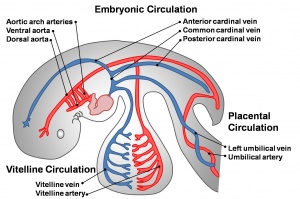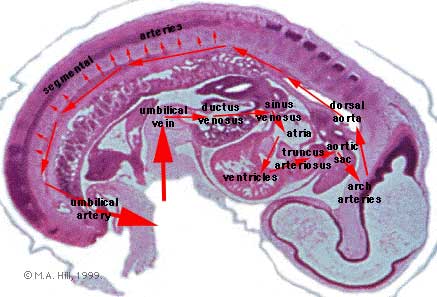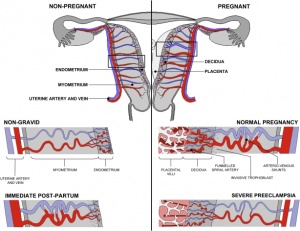2010 Lab 4
Cardiovascular and Placenta
Objectives
- Understand development of early embryo heart and vascular system.
- Understand the early placentation events and the development of placental blood vessels.
Introduction
This laboratory will explore the development of the embryonic cardiovascular system, which includes the placental vascular system. We will look through cross-sections of the Carnegie stage 14 embryo and follow the flow of blood through the embryonic vasculature. In this lab, we will also examine placentation.
Introduction
The vascular system of the embryo is formed from blood islands that appear in the extraembryonic mesoderm of the yolk sac and the embryonic mesoderm (primarily splanchnic mesoderm). Both of these clusters fuse together and extend, forming a vast network.
The early circulation has 3 components: Vitelline, Embryonic, Placental Each of these has its own system of arteries and veins.
- Vitelline - (not shown) the vitelline arteries branch off the dorsal aortas and enter the yolk sac, covering its entire surface. The vitelline veins return red blood cells from the capillary beds to the sinus venosus, posterior to the heart. The vitelline vessels eventually contribute to the portal system of the liver in the adult.
- Embryonic - blood from the dorsal aorta enters intersegmental arteries, including the arteries of the pharyngeal arches. The blood returns to the heart via the anterior and posterior cardinal veins.
- Placental - the umbilical arteries receive blood from the aorta. This is carried to the chorionic villi, where exchange occurs with the mother. Waste products are disposed of, nutrients and oxygen are collected, and then the umbilical veins convey the blood to the sinus venosus.
Heart - The heart develops from cardiogenic mesoderm, a region of splanchnic mesoderm lying above the buccopharyngeal membrane. Development begins in week 3 with the formation of a pair of heart tubes. These fuse and form a single tube in week 4, as a result of the embryonic folding processes that occur. As the heart grows, septation events occur, transforming it into a 4-chambered pump. Initially, the ventricles develop above the atria; however simultaneous growth and bending of the tube bring the structures into correct position. In humans, the heart begins to beat on day 22-23.
Stage 14 Embryo
Stage 14 3D CVS reconstruction Small movie page | large movie page | Stage 14 3D small movie | Stage 14 3D large movie
| A1 | A2 | A3 | A4 | A5 | A6 | A7 |
| B1 | B2 | B3 | B4 | B5 | B6 | B7 |
| C1 | C2 | C3 | C4 | C5 | C6 | C7 |
| D1 | D2 | D3 | D4 | D5 | D6 | D7 |
| E1 | E2 | E3 | E4 | E5 | E6 | E7 |
| F1 | F2 | F3 | F4 | F5 | F6 | F7 |
| G1 | G2 | G3 | G4 | G5 | G6 | G7 |
Compare this mid-embryonic cardiovascular system with that existing at the end of embryonic development Stage 22 3D CVS reconstruction
Placentation
Compare the features of a normal and gravid uterus.
Chorionic Villi
- Compare the features of primary, secondary, tertiary and stemmed villi
Mesenchymal stem cells in chorionic villi
Group projects
The laboratory will also allow time for work on the group online project. What have your other group members and other groups done so far?
UNSW Embryology Links
- Cardiovascular Slides Cardiovasular Lecture 7 2008 | Heart Lecture 2008 - 1 slide/page | Heart Lecture 2008 Slides - 4 slides/page | Heart Lecture 2008 Slides - 6 slides/page
- Cardiovascular Movies Heart Movies | Heart Looping | Atrial Septation | Realignment | Ventricular Septation | Heart Septation Models | Historic Heart Movie |
- Cardiovascular Notes Introduction | Abnormalities | Stage 13/14 | Stage 22 | Stage 22 Selected Highpower | Heart | Heart Rate | BloodBlood Vessels | Molecular | Lymphatic | Text only page | WWW Links | Postnatal | History - Harvey
- Placenta Slides Placenta Lecture 8 2008 | Placenta Lecture 2008 - 1 slide/page | Placenta Lecture 2008 Slides - 4 slides/page | Placenta Lecture 2008 Slides - 6 slides/page
- Placenta Movies Heart Movies | Heart Looping | Atrial Septation | Realignment | Ventricular Septation | Heart Septation Models | Historic Heart Movie |
- Placenta Notes Introduction | Abnormalities | Stage 13/14 | Human (Stage22) | Histology | Villi Development | Maternal Decidua | Vascular Beds | Molecular | Postnatal | Endocrine Placenta
- General Links System Notes | Development Timeline
Internet links
Embryo Images Unit: Embryo Images Online Early Cell Populations (cardiogenic section) | Cardiovascular Development | Week 3 Development | Week 4 Development | Heart Chambers and Outflow Tract | Atrioventricular Septation | Outflow Tract Septation | Ventricular Septation | Atrial Septation | Atrial Walls Aortic Arch Vessels | Changes at Birth
Glossary Links
- Glossary: A | B | C | D | E | F | G | H | I | J | K | L | M | N | O | P | Q | R | S | T | U | V | W | X | Y | Z | Numbers | Symbols | Term Link
Course Content 2009
Embryology Introduction | Cell Division/Fertilization | Cell Division/Fertilization | Week 1&2 Development | Week 3 Development | Lab 2 | Mesoderm Development | Ectoderm, Early Neural, Neural Crest | Lab 3 | Early Vascular Development | Placenta | Lab 4 | Endoderm, Early Gastrointestinal | Respiratory Development | Lab 5 | Head Development | Neural Crest Development | Lab 6 | Musculoskeletal Development | Limb Development | Lab 7 | Kidney | Genital | Lab 8 | Sensory - Ear | Integumentary | Lab 9 | Sensory - Eye | Endocrine | Lab 10 | Late Vascular Development | Fetal | Lab 11 | Birth, Postnatal | Revision | Lab 12 | Lecture Audio | Course Timetable
Cite this page: Hill, M.A. (2024, April 24) Embryology 2010 Lab 4. Retrieved from https://embryology.med.unsw.edu.au/embryology/index.php/2010_Lab_4
- © Dr Mark Hill 2024, UNSW Embryology ISBN: 978 0 7334 2609 4 - UNSW CRICOS Provider Code No. 00098G








